| English Electric Type 4 British Rail Class 50 | |||||||||||||||||||||||||||||||||||||||||
|---|---|---|---|---|---|---|---|---|---|---|---|---|---|---|---|---|---|---|---|---|---|---|---|---|---|---|---|---|---|---|---|---|---|---|---|---|---|---|---|---|---|
 A Class 50 at Birmingham New Street in 1987 A Class 50 at Birmingham New Street in 1987 | |||||||||||||||||||||||||||||||||||||||||
| |||||||||||||||||||||||||||||||||||||||||
| |||||||||||||||||||||||||||||||||||||||||
| |||||||||||||||||||||||||||||||||||||||||
| |||||||||||||||||||||||||||||||||||||||||
The British Rail Class 50 is a class of diesel locomotives designed to haul express passenger trains at 100 mph (160 km/h). Built by English Electric at the Vulcan Foundry in Newton-le-Willows between 1967 and 1968, the Class 50s were initially on a 10-year lease from English Electric Leasing, and were employed hauling express passenger trains on the then non-electrified section of the West Coast Main Line between Crewe and Scotland. Initially numbered D400–D449 and known as English Electric Type 4s, the locomotives were purchased outright by British Rail (BR) at the end of the lease and became Class 50 in the TOPS renumbering of 1973.
The class gained the nickname "Hoovers" because of the noise made by the clean air plant at the No. 2 end, prior to refurbishment, which was likened to that of a vacuum cleaner, a name believed given to them by the staff at Paddington Station. Once the electrification from Crewe to Glasgow was completed the locomotives were moved to the Great Western Main Line (GWML) out of Paddington to allow the retirement of most of the remaining diesel-hydraulic locomotives then in use. As trains on the GWML steadily moved to High Speed Train operation from 1976, the Class 50s moved to hauling trains between London Waterloo and Exeter St Davids, and also trains from London Paddington to Hereford and Worcester via Oxford until the majority of those trains too were taken over by IC125 operation. The class was steadily retired from service in the late 1980s and early 1990s as their services moved to operation by second-generation Class 159 DMUs.
Description
Development
The origins of the Class 50 lie in an invitation from the British Transport Commission (BTC) to manufacturers to produce a design for a lightweight Type 4 diesel locomotive with a gross power output of at least 2,500 hp. In order to produce a prototype quickly, English Electric based their design on that for their Deltic locomotives which were then in production. Unlike the Deltics, this design was powered by a single engine, the 16CSVT, a development of the 16SVT used in the Class 40 locomotives. Parts related to the contemporary Class 37s were also used. The result was DP2, a 2,700 hp Diesel-electric locomotive weighing 105 tons and with a top speed of 100 mph.
However, before the prototype could be completed, English Electric's design was rejected by the BTC, primarily on the grounds that the 16CSVT was unproven, and doubted its ability to produce the required power levels. Even after the delivery of DP2 in May 1962, any hope of future orders seemed over with the BTC's decision to standardise its Type 4 fleet on the Brush-Sulzer Class 47 design.
The DP2 design earned a reprieve in 1965, when the National Traction Plan of that year identified a need for an additional 50 Type 4 locomotives. By this time the Class 47 fleet were starting to suffer serious problems with engine stress cracking, a problem which necessitated the derating of the fleet to 2,580 hp. At the same time, DP2 and its 16CSVT engine had proved far more reliable than expected. Negotiations took place with English Electric for a production batch of 50 locomotives for use on the Eastern Region. English Electric intended to build the new batch as similar to DP2 as possible but the British Railways Board (successor to the BTC) had produced a standard locomotive cab with a flat front and headcode box and also had specific requirements relating to the engine room and other equipment. English Electric produced several alternative front-end designs including one with a wrap-around windscreen but the standard front-end design was eventually adopted for the class.
Production
The complete production run of 50 locomotives was built in just over a year and numbered from D400 to D449. D400 entered service in October 1967 and deliveries were completed with D449 in November 1968. Unusually, the ownership of the locomotives remained with the manufacturer and they were operated by British Rail on a 10-year lease which included certain stipulations relating to availability. The D prefix was quickly dropped for all diesel engines after steam was banned from British Rail's mainline in 1968. The Class 50 engines were numbered as 400 to 449 from 1969 to 1974.
Service
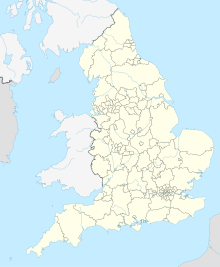 | ||
| Code | Name | Quantity |
|---|---|---|
| BR | Bristol Bath Road | 8 |
| CD | Crewe Diesel | 42 |
| Total: | 50 | |
The class was built for working passenger services on the West Coast Main Line (WCML) north of Crewe, to Preston, Lancaster, Carlisle, Glasgow Central and Perth, occasionally reaching as far north as Aberdeen. Services south of Crewe would generally be worked by an electric locomotive, with the Class 50s taking over for the journeys that continued north. Initially trains were hauled by a single locomotive, but from May 1970 they were paired on 8 out of 34 locomotive diagrams covering Anglo-Scottish services north of Crewe, allowing greatly accelerated timings to be applied (including a six-hour schedule for the "Royal Scot" London Euston-Glasgow Central and v.v. service). Once the electric service was introduced as far as Preston in 1973, this double-heading by Class 50s transferred there, although poor availability often resulted in single-heading with consequent delays. The ability to operate using multiple working had been part of the locomotive's initial design brief, but only two of the class had the facility from new, but with the introduction of the regular double headed duties, this facility was fitted to the whole class.

By 1974 the northern WCML was electrified, and the Class 50 fleet was displaced by new Class 87 electrics. The fleet was transferred to the Western Region between 1972 and 1976, working mainline passenger services from London Paddington along the Great Western Main Line (GWML) to destinations such as Oxford, Bristol Temple Meads, Plymouth and Penzance. It was not unusual for locomotives to work services on other routes, such as the Birmingham New Street to Bristol Temple Meads corridor. The introduction of the Class 50s on these routes enabled the last remaining, non-standard, diesel hydraulic "Westerns" to be withdrawn.
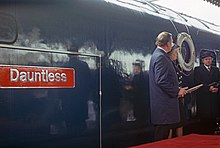
In the late-1970s, following a period where the policy of locomotive naming had been abandoned, BR was persuaded to name the class 50s after Royal Navy ships with notable records in World War I and II. As a result, the first locomotive naming occurred in January 1978, when 50035 was named Ark Royal by the captain and crew of then current aircraft carrier HMS Ark Royal. The rest of the fleet was named during the course of the next few years.
From 1977, British Rail introduced InterCity 125s onto the Great Western Main Line which began the displacement of the Class 50 fleet onto other routes, such as services to Birmingham New Street from London Paddington and Bristol Temple Meads. The class also found work on the West of England Main Line from London Waterloo to Salisbury, Exeter and Plymouth. However, due in part to the over-complexity of the design, the class was plagued with reliability problems which resulted in frequent service failures and cancellations. As a result, the decision was taken in the late 1970s to refurbish the entire fleet.
Refurbishment
To deal with increasing reliability problems, the Class 50 fleet was refurbished at Doncaster Works between 1979 and 1983. Doncaster had taken responsibility for the fleet after BR completed the purchase of the locomotives from English Electric. The work involved simplifying the complex electronics and removing redundant features such as slow speed control and rheostatic braking. In addition, the air intake fan arrangement was modified, because the original setup often prevented fresh air from entering the engine room and stale, oil mist-filled air from escaping, leading to many main generator failures. This was in part due to the moisture in the air in the UK: dust and other particles would lodge in the filter system and become 'gummed up' with moisture, preventing circulation which in turn also hampered the intended engine compartment pressure levels which then meant 'filtered' air could not be evacuated by the intended means. The filtration system was fundamentally sound and widely used in other countries; the problems arose because relative humidity had not been taken into account at the design stage. This modification eliminated the characteristic droning "sucking" noise which had earned the "Hoover" nickname.
Externally, the locomotives all received high-intensity headlights, which changed the appearance of the front end. Starting with 50006, the first six refurbished locomotives were outshopped in the standard BR Blue livery. However, 50006 Neptune and 50017 Royal Oak initially ran with blanking plates covering the headlight apertures, prior to headlights becoming available. In August 1980, 50023 Howe became the first to be outshopped in a revised livery with wrap around yellow cabs, black cab window surrounds, grey roof, large bodyside numerals and BR logo, in a livery that became known as BR Large Logo Blue. The final loco to be refurbished was 50014 Warspite, which was released back into traffic in December 1983. The last member of the class to be painted from original plain blue into the Large Logo blue livery was 50013 Agincourt, following release from an intermediate overhaul at Doncaster in September 1984.

Following refurbishment, the fleet was concentrated at two depots; Laira in Plymouth, and Old Oak Common in west London. The class were again used for Western Region services on the GWML out of Paddington, and on the West of England Main Line from Waterloo to Salisbury and Exeter.
In 1984, 50007 Hercules was repainted into lined Brunswick green livery and renamed Sir Edward Elgar, to commemorate the 150th anniversary of the Great Western Railway (GWR). Four Class 47 locomotives were similarly treated, and a Class 117 diesel multiple unit (DMU) was repainted in chocolate and cream livery. As a result, 50007 quickly became a favourite with rail enthusiasts. Another locomotive repainted in a special livery was 50019 Ramillies, which was repainted in a variation of BR Blue by staff at Plymouth Laira depot.

In 1986 the West of England Main Line came under the control of the Network SouthEast (NSE) sector, which saw the introduction of their bright blue, red and white livery. Two locomotives were repainted ready for the launch day on 10 June 1986, 50023 Howe and 50017 Royal Oak. In NSE livery, the nameplates were moved to a higher bodyside position. 50017 was the only member of the class to have one nameplate moved to an incorrect position, above the NSE branding, something which has been replicated in preservation. The third class member to be painted in the NSE scheme was 50035 "Ark Royal". Following an intermediate overhaul at Doncaster, the loco was released painted in grey primer, and worked a service train back to the Western Region as far as Bristol on 15 July 1986, prior to running to Old Oak Common depot for the NSE livery to be applied. The NSE livery had three versions; the original had upswept red, white and grey stripes at the ends, with white cab window surrounds, and a black roof; the first revision which came in 1987 had the red and white stripes continue to the body ends, with blue cab window surrounds, the original shade of blue was retained, 50044 Exeter and 50050 Fearless being the first two treated. The second revision and third variation of the NSE livery appeared in 1989, when the blue became a darker shade, 50043 Eagle and 50023 Howe, being the first two to appear. In 1990, Old Oak Common depot painted 50033 "Glorious" in NSE livery, and left the nameplates in their original position, so that the result read "Glorious Network SouthEast". To summarise, twenty-nine Class 50s received NSE livery, 50017 Royal Oak and 50048 Dauntless were the only locomotives to be painted in all three variations.
Towards the end of the 1980s, the fleet could be found mostly on the West of England route, as well as fast services from Paddington to Oxford. Some locomotives were also transferred to the civil engineers department to work maintenance and engineering trains. Around this time, the first locomotives were withdrawn, starting with 50011 Centurion in early 1987. This locomotive's nameplates were later transferred to 50040, which was previously named Leviathan. A further two locomotives, 50006 Neptune and 50014 Warspite were withdrawn in 1987, followed by a further five locomotives in 1988 (50010/13/22/38/47).
In 1987, consideration was given to using the class on freight trains. To this end, 50049 Defiance was renumbered to 50149, equipped with modified Class 37, lower-geared bogies and outshopped in the new trainload grey livery with Railfreight General decals. It was based at Plymouth Laira depot, and tested on local china clay trains in Cornwall as well as heavy stone trains to London from Devon quarries. The project was, however, not an outstanding success and by 1989 the locomotive had been returned to its original identity. Ironically, the electronic anti-wheelslip equipment, with which the entire class had originally been built and which would have been key to the success of this experiment, had been removed during the refurbishment process.

At the start of the 1990s, the reliability of the fleet became a problem again. By this time, the class was solely used on the West of England route, having been replaced on the Oxford route by Class 47/4 locomotives, displaced from Railfreight Distribution after the collapse of Speedlink in 1991. Arguably, the Class 50s were not suitable for the stop-start service pattern of Waterloo-Exeter services, nor to the extended single-line sections of this route, where a single locomotive failure could cause chaos. Therefore, the decision was taken to retire the remainder of the fleet, temporarily replacing them with Class 47/7 locomotives, which were in turn replaced by new diesel multiple units. From 1992, the Oxford route was worked by Class 165 and Class 166 units, whilst Class 159 units were introduced onto the West of England route in 1993.

By 1992, just eight locomotives remained in service, these being 50007/008/015/029/030/033/046/050. Several of these locomotives were specially repainted to commemorate the run-down of the fleet. The first-built locomotive, 50050 Fearless was renumbered D400 and painted in its original BR Blue livery. Two other locomotives, 50008 Thunderer and 50015 Valiant were also repainted, the former in a variation of BR Blue (the same as 50019 had previously carried), and the latter in "Dutch" civil-engineers grey/yellow livery. Of the final eight locomotives, three were retained until 1994 for use on special railtours, these being 50007 Sir Edward Elgar, 50033 Glorious and 50050 Fearless. 50007 was returned to working order using parts from 50046, which surrendered its recently overhauled power unit and bogies. By this time, 50050 had been repainted into Large Logo livery and 50007 also received a repaint into GWR green as the 1985 paint was wearing very thin. The final railtours operated in March 1994, during one of which 50033 was delivered for preservation at the National Railway Museum. The final railtour operated with 50007 and 50050 from London Waterloo to Penzance and returning to London Paddington. Both locomotives were later preserved.
Accidents and incidents
- On 23 November 1983, a sleeper train hauled by 50 041 Bulwark was derailed on the approach to Paddington due to excessive speed through a crossover. Three of the seventy passengers were injured.
- On 6 August 1989, 50025 Invincible was derailed at West Ealing whilst hauling the 21:15 Oxford to Paddington service. The cause was a length of rail that vandals had placed across the track. There were no fatalities and the locomotive was subsequently scrapped in October that year.
Fleet list
| This section needs additional citations for verification. Please help improve this article by adding citations to reliable sources in this section. Unsourced material may be challenged and removed. Find sources: "British Rail Class 50" – news · newspapers · books · scholar · JSTOR (August 2022) (Learn how and when to remove this message) |
| Key: | Scrapped | Preserved |
|---|
| Number | Name | Built | Named | Withdrawn | Status | Notes | |
|---|---|---|---|---|---|---|---|
| Pre-TOPS | TOPS | ||||||
| D400 | 50050 | Fearless | 17.10.67 | 23.08.78 | 26.03.94 | Preserved | Carried nameplate 04.08.78 – 07.08.78. Now owned by Boden Rail Engineering Ltd. |
| D401 | 50001 | Dreadnought | 09.12.67 | 10.04.78 | 19.04.91 | Scrapped | Scrapped at Booth-Roe scrapyard, Rotherham in December 2002. |
| D402 | 50002 | Superb | 12.67 | 21.03.78 | 09.09.91 | Preserved | Preserved by the Devon Diesel Society. It is currently being restored at the South Devon Railway in Buckfastleigh. |
| D403 | 50003 | Temeraire | 01.68 | 09.05.78 | 15.07.91 | Scrapped | Scrapped at MC Metals scrapyard, Glasgow in April 1992. |
| D404 | 50004 | St Vincent | 12.67 | 09.05.78 | 22.06.90 | Scrapped | Scrapped at Booth-Roe scrapyard, Rotherham in May 1992. |
| D405 | 50005 | Collingwood | 01.68 | 05.04.78 | 11.12.90 | Scrapped | Scrapped at Old Oak Common TMD, London in February 1991. |
| D406 | 50006 | Neptune | 04.68 | 25.09.79 | 20.07.87 | Scrapped | First Class 50 to be refurbished. Scrapped at Vic Berry's scrapyard, Leicester in February–March 1988. |
| D407 | 50007 | Hercules | 03.68 | 06.04.78 | 16.07.91 / 26.03.94 | Preserved | Renamed Sir Edward Elgar on 25.02.84. Originally withdrawn in 1991. Reinstated for railtour use in 1992. Renamed back to Hercules in early 2014. Now owned by Class 50 Alliance. |
| D408 | 50008 | Thunderer | 03.68 | 01.09.78 | 05.06.92 | Active | Owned by Hanson & Hall Rail Solutions, returned to mainline in June 2021 |
| D409 | 50009 | Conqueror | 03.68 | 08.05.78 | 11.01.91 | Scrapped | Scrapped at Old Oak Common TMD, London in February 1991. |
| D410 | 50010 | Monarch | 03.68 | 16.03.78 | 27.09.88 | Scrapped | Scrapped at Laira TMD, Plymouth by Coopers in May 1992. |
| D411 | 50011 | Centurion | 04.68 | 17.09.79 | 24.02.87 | Scrapped | First Class 50 to be withdrawn. Scrapped at Crewe Works by Texas Metals in September 1992. |
| D412 | 50012 | Benbow | 04.68 | 03.04.78 | 16.01.89 | Scrapped | Scrapped at Vic Berry's scrapyard, Leicester in July 1989. |
| D413 | 50013 | Agincourt | 04.68 | 19.04.78 | 06.04.88 | Scrapped | Scrapped at Old Oak Common TMD, London in July 1989. |
| D414 | 50014 | Warspite | 05.68 | 30.05.78 | 14.12.87 | Scrapped | Scrapped at Vic Berry's scrapyard, Leicester in May–July 1989. |
| D415 | 50015 | Valiant | 04.68 | 21.04.78 | 05.06.92 | Preserved | Owned by the Bury Valiant Group. |
| D416 | 50016 | Barham | 05.68 | 03.04.78 | 03.08.90 | Scrapped | Scrapped at Booth-Roe scrapyard, Rotherham in June 1992. |
| D417 | 50017 | Royal Oak | 04.68 | 24.04.78 | 09.09.91 | Preserved | Owned by Michael Gregory, Great Central Railway as of February 2019. |
| D418 | 50018 | Resolution | 04.68 | 06.04.78 | 22.07.91 | Scrapped | Scrapped at MC Metals scrapyard, Glasgow in January 1993. |
| D419 | 50019 | Ramillies | 05.68 | 18.04.78 | 19.09.90 | Preserved | Owned by the Class 50 Locomotive Association, Mid Norfolk Railway. |
| D420 | 50020 | Revenge | 05.68 | 07.07.78 | 27.07.90 | Scrapped | Scrapped at Booth-Roe scrapyard, Rotherham in June 1992. |
| D421 | 50021 | Rodney | 05.68 | 31.07.78 | 17.04.90 | Preserved | Owned by Paul Spracklen, Eastleigh Works. |
| D422 | 50022 | Anson | 05.68 | 20.04.78 | 20.09.88 | Scrapped | Scrapped at Vic Berry's scrapyard, Leicester in May–June 1989. |
| D423 | 50023 | Howe | 06.68 | 17.05.78 | 15.10.90 | Scrapped | Scrapped at Barrow Hill, Chesterfield in March 2004. |
| D424 | 50024 | Vanguard | 06.68 | 15.05.78 | 01.02.91 | Scrapped | Scrapped at Old Oak Common TMD, London in July 1991. |
| D425 | 50025 | Invincible | 07.68 | 06.06.78 | 14.08.89 | Scrapped | Scrapped at Old Oak Common TMD in October 1989, after derailment at West Ealing in August 1989. The derailment was a result of vandals placing an object onto the track, causing the loco to overturn. |
| D426 | 50026 | Indomitable | 07.68 | 29.03.78 | 11.12.90 | Preserved | Owned by Paul Spracklen. |
| D427 | 50027 | Lion | 06.68 | 17.04.78 | 23.07.91 | Preserved | Privately owned. Based at the Mid-Hants Railway. It was based at the North Yorkshire Moors Railway from 1992 until 13 June 2012. |
| D428 | 50028 | Tiger | 07.68 | 10.05.78 | 01.02.91 | Scrapped | Scrapped at Old Oak Common TMD, London in July 1991. |
| D429 | 50029 | Renown | 07.68 | 26.10.78 | 25.03.92 | Preserved | Owned by the Renown Repulse Restoration Group. |
| D430 | 50030 | Repulse | 07.68 | 10.04.78 | 08.04.92 | Preserved | Owned by the Renown Repulse Restoration Group. |
| D431 | 50031 | Hood | 07.68 | 28.06.78 | 05.08.91 | Preserved | Operated by the Class 50 Alliance. |
| D432 | 50032 | Courageous | 07.68 | 07.07.78 | 15.10.90 | Scrapped | Scrapped at Old Oak Common TMD, London in February 1991. |
| D433 | 50033 | Glorious | 08.68 | 26.06.78 | 25.03.94 | Preserved | Currently based at the Severn Valley Railway. |
| D434 | 50034 | Furious | 08.68 | 06.04.78 | 29.06.90 | Scrapped | Scrapped at Old Oak Common TMD, London in February 1991. |
| D435 | 50035 | Ark Royal | 08.68 | 17.01.78 | 03.08.90 | Preserved | First to be named and preserved. Owned by the Class 50 Alliance. Currently based at the Severn Valley Railway. |
| D436 | 50036 | Victorious | 09.68 | 16.05.78 | 12.04.91 | Scrapped | Scrapped at Booth-Roe scrapyard, Rotherham in July 1992. |
| D437 | 50037 | Illustrious | 09.68 | 08.06.78 | 09.09.91 | Scrapped | Scrapped at MC Metals scrapyard, Glasgow in December 1992. One cab preserved at the Llanelli & Mynydd Mawr Railway. Second cab stored at Peak Rail with Renown Repulse Restoration Group locos 50029 & 50030 |
| D438 | 50038 | Formidable | 10.68 | 05.05.78 | 27.09.88 | Scrapped | Scrapped at Old Oak Common TMD, London in July 1989. |
| D439 | 50039 | Implacable | 10.68 | 20.06.78 | 04.06.89 | Scrapped | Scrapped at Old Oak Common TMD, London in July 1991. |
| D440 | 50040 | Leviathan | 10.68 | 15.09.78 | 03.08.90 | Scrapped | Scrapped at Sims Metal Management, Halesowen in June–July 2008. |
| D441 | 50041 | Bulwark | 10.68 | 08.05.78 | 17.04.90 | Scrapped | Scrapped at Old Oak Common TMD, London in July 1991. |
| D442 | 50042 | Triumph | 10.68 | 04.10.78 | 15.10.90 | Preserved | Preserved at the Bodmin and Wenford Railway. |
| D443 | 50043 | Eagle | 10.68 | 28.06.78 | 01.02.91 | Scrapped | Scrapped for spares at Blaenavon by Rexstar in January 2002. |
| D444 | 50044 | Exeter | 11.68 | 26.04.78 | 11.01.91 | Preserved | Owned by the Class 50 Alliance. |
| D445 | 50045 | Achilles | 11.68 | 12.04.78 | 11.12.90 | Scrapped | Scrapped at Booth-Roe scrapyard, Rotherham in April 2000. |
| D446 | 50046 | Ajax | 12.68 | 11.10.78 | 25.03.92 | Scrapped | Scrapped at MC Metals scrapyard, Glasgow in June 1992. One cab privately preserved near Looe, Cornwall. |
| D447 | 50047 | Swiftsure | 12.68 | 26.05.78 | 13.04.88 | Scrapped | Scrapped at Vic Berry's scrapyard, Leicester in April–June 1989. |
| D448 | 50048 | Dauntless | 12.68 | 16.03.78 | 15.07.91 | Scrapped | Scrapped at MC Metals scrapyard, Glasgow in April 1992. |
| D449 | 50049 50149 |
Defiance | 12.68 | 02.05.78 | 16.08.91 | Preserved | Owned by the Class 50 Alliance. 50149 carried during trial of using the class on freight trains. |
Portuguese locomotives

The Portuguese Railways, CP, bought ten locomotives similar to the BR Class 50, but built to Iberian track gauge (1,668 mm). These locomotives, designated by CP as "Série 1800" (numbered 1801–1810), entered service in 1968.
Like the British Class 50s, they were equipped with an English Electric 16 CSVT engine and produced 2700 hp (2020 HP at the wheels). Unlike the BR locomotives upon which electronic control is extensively used, the Portuguese locomotives employ conventional control gear (the only exceptions being stepless control of tractive effort by a solid-state load regulator and the use of a very effective out-of-balance wheel-slip detector). The main generator and the traction motors are identical to those used on the BR Type 3 and Deltic locomotives. Contrary to BR Class 50, the Portuguese Série 1800 locomotives were built to be as much compatible with the smaller Série 1400 (themselves similar to BR Class 20) as possible and also to use as many common components as possible.
They were the only diesel locomotives in Portugal authorised to run at 140 km/h. The CP Série 1800s were all withdrawn in 2001 and (as of 2012) several have been cut up, and the future of the rest is unclear.
Locomotive 1805 has been preserved in operational condition by the Portuguese National Railway Museum at Entroncamento. Since the 1980s it had been painted in CP's corporate orange livery, but it has been repainted in its original distinctive blue livery by the CP workshop at Contumil near Porto. While still an integral part of the National Railway Museum, it is set to return to service pulling tourist trains on the Douro River Line.
Preservation
| This section needs additional citations for verification. Please help improve this article by adding citations to reliable sources in this section. Unsourced material may be challenged and removed. Find sources: "British Rail Class 50" – news · newspapers · books · scholar · JSTOR (November 2022) (Learn how and when to remove this message) |
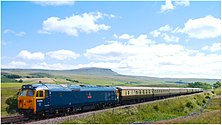
Class 50 locomotives proved popular with rail enthusiasts, with eighteen locomotives, including the first production unit, saved for preservation and several subsequently registered for use on the mainline.
An ambitious project involving preserved Class 50s was "Operation Collingwood", an engineering charity established in the early 1990s. The aim had been to train young engineering apprentices by getting them to rebuild railway locomotives and Class 50s were chosen both for the fact that they were a British design throughout and that all were named (so the apprentices would derive some pride from rededication ceremonies at the completion of their work). To this end, Operation Collingwood purchased and stored 50001, 50023, 50029, 50030, 50040 and 50045. All except 50029 and 50030 were heavily stripped examples sold to scrapyards for final cutting up. The intention was to restore them by using industrial sponsorship money to build an engineering centre and overhaul the components, making brand new ones where necessary to overcome lack of availability of some parts unique to the original design. These ambitions failed when sponsorship did not reach the required level and the project lost various key people. The charity was wound up in 2002; 50001/023/040 and 045 were sold back to scrapyards and their state as little more than bodyshells deterred most further preservation attempts. 50045 was scrapped to provide spares for preserved 50026, and 50001 met a similar fate. A private individual made an attempt to restore 50023 using some parts from 50001 but this was abandoned and the shell was cut up a few years after the initial purchase. 50040 could have been suitable for cosmetic restoration, but after many years untouched and in a derelict state at the Coventry Railway Centre, it finally had all remaining parts stripped for spares and was transported to Sims Metals of Halesowen for scrapping. The cutting of the derelict hulk was completed by Wednesday 2 July 2008. 50029 and 50030 were in far better mechanical condition, and were sold to a preservation group for full restoration.
50043 Eagle was purchased in almost working order (the main generator had failed, a very common Class 50 problem) but it was never intended for restoration. Instead the power unit was gutted to provide parts for preserved Class 40 no. 40118 as the two share a very similar design of diesel engine. Eagle was then subjected to a further bout of stripping when electrical and other parts were sold to various Class 50 preservationists. Although cosmetically very smart, the loco was by this stage unrestorable and although an ambitious private individual did try, this effort soon came to naught and it was scrapped to provide parts for 50026 Indomitable. 50026 itself was rescued from Booth's Scrapyard in 1993.
Once preserved, 50002 became the first class 50 to operate a train for a private excursion on the South Devon Railway (April 1992), while 50031 was the first to operate a train for fare paying passengers (Severn Valley Railway May 1992). 50031 was also the first to operate on the mainline, hauling the Past Time Railtours Pilgrim Hoover train from Birmingham International to Plymouth on 1 November 1997. Since then several other members of the class have also been passed for use on Network Rail (was Railtrack) lines. However, with changes in the UK's Rail Access regulations (requiring fitment of additional equipment: TPWS/OTMR/GSMR) some of these locos are no longer of a standard to continue mainline operation. At present, 50007, 50008, 50044, 50049 & 50050 are passed for main line running. The owner of 50021 & 50026 aims to restore them to mainline use in the near future.
One locomotive, 50017, was hired to Venice Simplon Orient Express (VSOE) to work the Northern Belle service from Bath to Manchester Victoria. As part of the contract it was painted in LMS-style maroon livery. Following this, the loco spent several years dumped at Tyseley locomotive works before being sold to a private individual. The loco was then restored to working order at the Plym Valley Railway, before being sold to Boden Railway Engineering a few years later. In Feb 2019 the engine was sold from Boden Rail to the Great Central Railway minus its mainline equipment.
In 2003, the National Railway Museum decided to dispose of 50033 due to an inability to commit to maintenance and storage costs. This was subject to a suitable owner being found for what was now a museum asset. After spending a period on loan to the North Yorkshire Moors Railway in 2004 the locomotive was moved to the Swindon Steam Railway Museum. However, soon after it was sent on to the Tyseley Locomotive Works as part of a proposed move to the RailSchool project and Royal Docks Heritage Railway in North Woolwich, London. When the Crossrail project was authorised, this scheme fell by the wayside, stranding 50033 at the Birmingham Railway Museum (Tyseley). After a period the ownership of the loco was transferred between the museums in lieu of storage payments. Unfortunately due to lack of covered accommodation the loco was stored in the open. This situation ended in February 2018, when an agreement between the Birmingham Railway Museum and the Fifty Fund was reached to return the locomotive to operational use. As part of this arrangement the locomotive was moved to the Severn Valley Railway in May of the same year. After an intense restoration effort the loco hauled trains at the Class 50 Golden Anniversary Gala in October 2018. As the loco was still in undercoat, it was possible for gala attendees to graffiti the loco body for a payment towards its full repaint – an exercise that raised over £3,800.
In 2005, 50031 and 50049 were on long term hire to Arriva Trains Wales (ATW), for use on special services in connection with events at the Millennium Stadium, and over the summer period saw regular use on the Monday to Saturday "Fishguard Flyer" from Cardiff to Fishguard and return, in connection with the ferry sailing to Ireland. One of the two locomotives was used for the service each day, along with 4 Mark 2 coaches, the short formation and high power leading to very good performance. This arrangement lasted for one year. At the end of this period 50031 failed whilst working an ECS (Empty Coaching Stock) train, again for ATW.
During the summer of 2008 50044 "Exeter" was fitted with OTMR, and the TPWS fitted previously was commissioned. In October 2008 '44 was re-registered for mainline use, and operated its first revenue mainline train on 18 October 2008, when it worked, in multiple with 50049 "Defiance" on a railtour from Manchester Piccadilly to Minehead.
Several owning groups have ceremonially re-dedicated their locomotives to the warships whose names they carry. The HMS Hood Association rededicated 50031 Hood at the Mid Hants Railway, unveiling new crests. The crew of HMS Exeter re-dedicated D444 Exeter at the Severn Valley Railway a year before the vessel was decommissioned, unveiling a crest and early-BR-style nameplates. The captain of HMS Ark Royal performed the re-dedication ceremony for 50135 Ark Royal at the Eastleigh 100 Open Days.
October 2018 saw the Severn Valley Railway host the 'Class 50 Golden Jubilee' gala, celebrating fifty years since the class was introduced into traffic. Eleven of the eighteen preserved 50s attended the event, these being: 50007, 50008, 50015, 50017, 50026 (non-operational), 50031, 50033, 50035, 50044, 50049 and 50050. This made it the largest gathering of a single type of locomotive in preservation history. Of significance was 50033, which had undergone a speedy overhaul since transferring to the railway in May of that year, hauling its first passenger trains since 2004.
Seven of the preserved Class 50s have operated on the mainline in preservation, these being: 50050 Fearless, 50007 Hercules, 50008 Thunderer, 50017 Royal Oak, 50031 Hood, 50044 Exeter and 50049 Defiance.
List of preserved locomotives
| Numbers (Current in Bold) | Name | Image | Livery | Location | Notes | ||
|---|---|---|---|---|---|---|---|
| D400 | 50050 | - | Fearless | 
|
BR Blue | Nottingham Eastcroft TMD | Owned by Boden Rail Engineering Ltd. First-built locomotive.
Operational, Mainline certified |
| D402 | 50002 | - | Superb | 
|
BR Blue | South Devon Railway | Under restoration. |
| D407 | 50007 | - | Hercules | 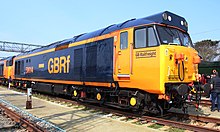
|
BR Blue Large Logo | Severn Valley Railway | Operational, Mainline Certified. On spot-hire to GBRf. |
| D408 | 50008 | - | Thunderer | 
|
Hanson & Hall | Kings Norton | Re-entered preservation in 2006. Repainted by ELR 2009–2010. Operational, Mainline Certified 2017 |
| D415 | 50015 | - | Valiant | 
|
BR Blue Large Logo | East Lancashire Railway | Only Class 50 to carry "Dutch" civil-engineers livery in BR ownership. Preserved by Bury Valiant Group
Operational |
| D417 | 50017 | 50117 | Royal Oak | 
|
Network SouthEast (Original) | Great Central Railway. | Preserved & Operational. Previously Mainline Certified. |
| D419 | 50019 | - | Ramillies | 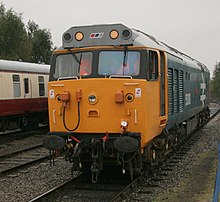
|
BR Blue Large Logo | Mid-Norfolk Railway | Taken out of service for works in 2013. |
| D421 | 50021 | - | Rodney | 
|
BR Blue Large Logo | Eastleigh | Operational. Restoration completed 2023. |
| D426 | 50026 | - | Indomitable | 
|
Network SouthEast (Revised) | Eastleigh | Undergoing maintenance. Fitted with OTMR, TPWS and GSMR equipment for future mainline operation. Currently in the final stages of an engine overhaul. |
| D427 | 50027 | - | Lion | 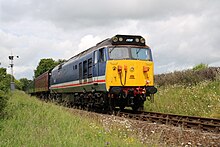
|
Network SouthEast (Revised) | Mid Hants Railway | Operational |
| D429 | 50029 | - | Renown | 
|
BR Blue Large Logo (Black Roof) | Peak Rail | Awaiting Restoration |
| D430 | 50030 | - | Repulse | 
|
BR Blue Large Logo | Peak Rail | Under Restoration |
| D431 | 50031 | - | Hood | 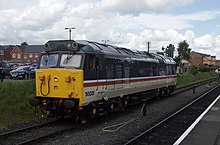
|
Intercity Swallow | Severn Valley Railway | Operational. Currently carries non-prototypical Intercity livery. |
| D433 | 50033 | - | Glorious | 
|
BR Blue Large Logo | Severn Valley Railway | Previously at Swindon Steam Railway Museum and Tyseley Locomotive Works.
Operational. |
| D435 | 50035 | 50135 | Ark Royal | 
|
BR Blue | Severn Valley Railway | Operational. |
| D442 | 50042 | - | Triumph | 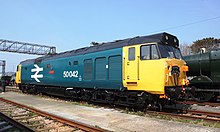
|
BR Blue Large Logo (Black Roof) | Bodmin & Wenford Railway | Operational. |
| D444 | 50044 | - | Exeter | 
|
BR Blue | Severn Valley Railway | Operational. Mainline Certified. |
| D449 | 50049 | 50149 | Defiance | 
|
BR Blue Large Logo | Severn Valley Railway | Operational. Mainline Certified. On spot-hire to GBRf. |
Model railways
Lima produced the first model of the Class 50 in OO gauge – initially in unrefurbished condition – with Graham Farish producing the type in British N gauge. Neither of these models are now available new, but second-hand models do appear from time to time.
In 2003, Hornby Railways launched its first version of the BR Class 50 in OO gauge. Hornby have since updated the Class 50 and have produced models of 50007 Hercules and 50049 Defiance in GBRF colours as part of their 2020 range.
Recently, Heljan have also made models of Class 50 in O gauge which includes 50007 Hercules as Sir Edward Elgar in GWR green, 50149 Defiance in BR Railfreight general sector triple grey, 50017 Valiant in BR Civil Engineers 'Dutch' grey and yellow and 50008 Thunderer in BR Laira Blue as well as unnamed and unnumbered 50s in BR Blue, and in the original and revised Network South East livery.
Dapol have also released a model of the Class 50 in British N gauge which include samples in BR Blue, BR large logo Blue and the original NSE livery.
Accurascale announced in November 2022 that they would be producing a newly tooled OO gauge Class 50 model, based on a 3D laser scan taken of locomotive 50017 at the Great Central Railway in 2019.
References
Citations
- ^ Cotter, Jarrod (2017). English Electric Class 50 1967 Onwards (all models) Owner's Workshop Manual. Sparkford, Somerset: Haynes Publishing. p. 1. ISBN 978-1-78521-060-0.
- Clough, David N (2011). Hydraulic vs Electric: The battle for the BR diesel fleet. Hersham: Ian Allan. p. 100. ISBN 978-0-7110-3550-8.
- Clough, David N (2011). Hydraulic vs Electric: The battle for the BR diesel fleet. Hersham: Ian Allan. p. 101. ISBN 978-0-7110-3550-8.
- "Why the '50s' triumphed in class struggle". Rail Magazine. Archived from the original on 1 January 2019. Retrieved 31 December 2018.
- Marsden, Colin J. "Design and Building". Modern Railways Pictorial Profile. No. 4: Class 50s. Shepperton: Ian Allan. p. 4. ISSN 0264-3642.
- ^ Marsden, Colin J. "Design and Building". Modern Railways Pictorial Profile. No. 4: Class 50s. Shepperton: Ian Allan. p. 5. ISSN 0264-3642.
- Chalcraft, John (1985). Portrait of the 50s. Bristol: Rail Photoprints. p. 1. ISBN 0-906883-07-5.
- British Railways Locoshed Book 1974 edition. Shepperton: Ian Allan. 1974. p. 53. ISBN 0-7110-0558-3.
- ^ Clough, David (2004). Class 50s in Operation. Hersham: Ian Allan Publishing. ISBN 0-711029-71-7.
- Perren, Brian (December 1971). "Five years "under the wire" – 2". Railway World. Vol. 32, no. 379. Shepperton: Ian Allan. pp. 528–531.
- English Electric Traction for Egypt – EE Co Publicity Document E438, English Electric, 1961
- Horner, Ian (2013). Class 50 The Large Logo Years.
- Class 50 Finale - The Laira Years (DVD). Locomaster Profiles. 2010. Archived from the original on 3 June 2019. Retrieved 12 September 2024.
- Nicholson-Lord, David (24 November 1983). "Eleven coaches derailed in Paddington sleeper crash". The Times. No. 61698. London. col B-F, p. 32.
- Department of Transport (18 February 1985). Report of the derailment that occurred on 23rd November 1983 at Paddington Station (PDF). Her Majesty's Stationery Office. ISBN 0-11-550686-1. Archived (PDF) from the original on 30 June 2013. Retrieved 18 June 2016.
- "Accident at West Ealing in August 1989". Railways Archive. Archived from the original on 2 May 2023. Retrieved 17 November 2017.
- "Class 50 Locomotive Names". Class50.com. Archived from the original on 26 September 2010. Retrieved 2 October 2010.
- "Devon Diesel Society – Locos D2246, D6737 and D402". devondiesels.org.uk. Archived from the original on 13 September 2024. Retrieved 16 October 2018.
- ^ "Class 50 Alliance". Archived from the original on 4 October 2008. Retrieved 28 January 2009.
- ^ "Renown Repulse Restoration Group". www.renownrepulse.com. Archived from the original on 27 August 2024. Retrieved 12 September 2024.
- "The Cabs – The Cab Yard". Archived from the original on 13 September 2024. Retrieved 7 December 2022.
- "Renown Repulse Restoration Group". Archived from the original on 17 April 2023. Retrieved 17 April 2023.
- "History The Cab Yard Story – The Cab Yard". Archived from the original on 13 September 2024. Retrieved 7 December 2022.
- "50026 Indomitable". English Electric Archive. Archived from the original on 3 March 2021. Retrieved 3 October 2020.
- Travers, Chris. "Diesel Update – November 2017". Epping Ongar Railway. Diesel Restoration Group. Archived from the original on 6 October 2021. Retrieved 3 October 2020.
- "D402 – English Electric Type 4 – BR Class 50 – 50 002 - South Devon Railway". 4 December 2017. Archived from the original on 8 December 2023. Retrieved 15 December 2023.
- ^ "Large Logo Duo Return". The Fifty Fund (Press release). Archived from the original on 13 September 2024. Retrieved 12 September 2024.
- ^ "GB Railfreight and Class 50 Alliance collaboration sealed with locomotive repaints". gbrailfreight.com (Press release). 15 January 2019. Archived from the original on 21 August 2014. Retrieved 15 January 2019.
- "50021 Rodney". English Electric Archive - British Rail Class 50 locomotives. Archived from the original on 1 June 2023. Retrieved 1 June 2023.
- "Hornby BR Class 50". Hornby Railways Collector Guide. Archived from the original on 11 January 2020. Retrieved 31 January 2020.
- "Class 50s – from Accurascale". World of Railways. Bourne: Warners Group Publications. 23 November 2022. Archived from the original on 23 November 2022. Retrieved 23 November 2022.
Further reading
- Ballantyne, Hugh (2014). Class 50s to the Cornish Riviera. Book Law Publications. ISBN 9781909625211.
- Beckett, M.J. (1983). The Class 50 Story. Fearless Publications. ISBN 9780950935409. OCLC 655706030.
- Brooks, Chris; Szwejkowski, Richard (1997). Class 50s on Tour. Peter Watts. ISBN 9780906025581. OCLC 862609132.
- Coward, Andy; Horner, Ian; Thompson, Richard (2010). First of the Last: The Life and Times of 50050 Fearless. The D400 Fund. ISBN 9780956610706.
- Denton, Brian; Warwick, David, eds. (1991). Main Line Colour Albums No.1: The Class 50s. Airtime Publishing Ltd. ISBN 9780951850701. OCLC 59899657.
- Derrick, Kevin (2004). Heritage Traction in Colour: The Class 50s. Trans-Pennine Publishing Ltd. ISBN 9781903016404.
- Derrick, Kevin (2011). Looking back at Class 50 Locomotives. Strathwood. ISBN 9781905276455.
- Gillham, G.F. (1983). Class 50s on the Western. Becknell. ISBN 9780907087212. OCLC 12450338.
- Marsden, Colin J. (1991). Life & Times Series: Class 50. OPC. ISBN 9780860934202. OCLC 22626487.
- Marsden, Colin J. (1988). Locomotive Recognition: Class 50s. Ian Allan. ISBN 9780711017825. OCLC 19266339.
- Marsden, Colin J.; Fenn, Graham B. (1988). British Rail Main Line Diesel Locomotives. Sparkford: Haynes. pp. 212–219. ISBN 9780860933182. OCLC 17916362.
- Oakley, Michael (1979). The Fifty – Fifties EE Class 50 Diesel Electrics. Bradford Barton. ISBN 9780851533544. OCLC 60077372.
- Saunders, Kevin; Cough, David N. (1998). Class 50 Factfile. Fearless Publications. ISBN 9780950935430. OCLC 867913413.
- Siviter, Roger (2001). Class 50s on the Route from Waterloo to Exeter. Silver Link Publishing Ltd. ISBN 9781857941470. OCLC 862602336.
- Vaughan, John (1986). Class 50s at Work. Littlehampton Book Services Ltd. ISBN 9780711013889. OCLC 17261126.
- Vaughan, John (1983). Profile of the Class 50s. OPC. ISBN 9780860932338. OCLC 11840595.
- Vehicle Diagram Book No. 100 for Main Line Diesel Locomotives (PDF). Derby: British Railways Board. October 1984. pp. 33, 38–39, 136 (per pdf) – via Barrowmore MRG.
- Woodhouse, Mike; Griffiths, Andy (1994). Thundering fifties: further reminiscences of a Class 50 fitter at Laira. Wolfhayes Publications. ISBN 9780952304609. OCLC 867913367.
- Johnston, Howard (October 1982). "New locos for old!". Rail Enthusiast. EMAP National Publications. pp. 6–11. ISSN 0262-561X. OCLC 49957965.
- "The Flying Fifties". Rail Enthusiast. EMAP National Publications. January 1983. pp. 26–27. ISSN 0262-561X. OCLC 49957965.
- Johnston, Howard (May 1984). "A '50' in Brunswick green". Rail Enthusiast. EMAP National Publications. pp. 28–33. ISSN 0262-561X. OCLC 49957965.
- Clough, David (October 1988). "50s in view". RAIL. No. 90. EMAP National Publications. pp. 38–44. ISSN 0953-4563. OCLC 49953699.
- Vaughan, John (4–17 May 1989). "The one year life of a china clay Class 50". RAIL. No. 95. EMAP National Publications. pp. 38–41. ISSN 0953-4563. OCLC 49953699.
- "'50s' future in doubt as Operation Collingwood rethinks its strategy". RAIL. No. 339. EMAP Apex Publications. 9–22 September 1998. p. 56. ISSN 0953-4563. OCLC 49953699.
- "Portuguese power unit to be used for rebuild of 50044 Exeter". RAIL. No. 710. Peterborough: Bauer. 28 November – 11 December 2012. pp. 26–27. ISSN 0953-4563. OCLC 49953699.
- Dunn, Pip; Sherwood-Jones, Darren; Dent, George (April 2006). "Cult Classics". Model Rail. No. 90. Peterborough: EMAP Active. pp. 20–28, 30–31. ISSN 1369-5118. OCLC 173324502.
- "Ex-NRM 'Hoover' ownership settled". The Railway Magazine. Vol. 159, no. 1345. Horncastle: Mortons Media Group. May 2013. p. 96. ISSN 0033-8923. OCLC 750645684.
External links
- 50015 Bury Valiant Group – Information on D415/50015 based at the East Lancashire Railway
- The Fifty Fund – Supporters group for the locomotives owned and operated by The Class 50 Alliance Ltd. – Information on all class 50s and specific coverage of 50007 Hercules, 50031 Hood, 50035 Ark Royal, 50044 Exeter and 50049 Defiance all nominally based at the Severn Valley Railway
- Class 50 loco-by-loco photo gallery
- English Electric Archive – gallery dedicated to English Electric Type 4 Co-Co (British Rail Class 50) locomotives in preservation and their restoration
- 50042 Archived 1 June 2016 at the Wayback Machine – Information on 50042 Triumph based at the Bodmin and Wenford Railway
| British railway locomotives and miscellany, 1948 to present | |
|---|---|
| Diesel shunters | |
| Diesel shunters (pre-TOPS) | |
| Main-line diesels: | |
| Main-line diesels (pre-TOPS) | |
| Electrics | |
| Electrics (pre-TOPS) | |
| Multi-modes | |
| Departmental | |
| Prototypes | |
| Getlink locomotives | |
| Steam locomotives | |
| Ships | |